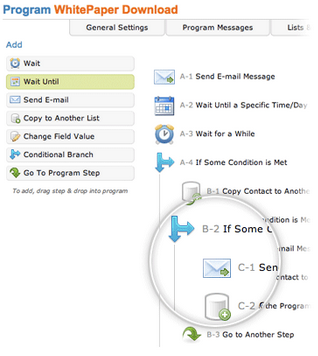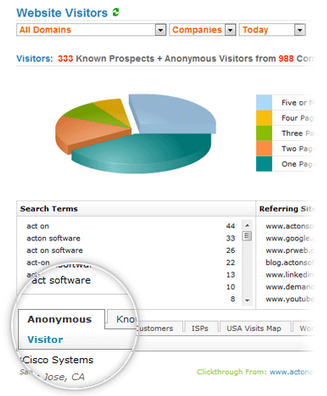- Share Act-On Software Review on Facebook
- Share Act-On Software Review on Twitter
- Share Act-On Software Review on Linkedin
- Share Act-On Software Review via email
What it does
Act-on is a relatively new player in the marketing automation space, founded by some of the people behind Amazon’s collaborative filtering based recommendation engine. Their software performs the basic functions of a marketing automation system at a lower cost than most of the established players in the marketing automation industry. Some of the core areas of functionality for Act-on Software include:
Landing Pages
Using Act-on, you can create landing page sign up forms for lead capture. For example, you can use Act-on landing pages for capturing demo and trial request on your website. Or for requesting lead information on white papers, eBooks, and other asset downloads, or for a pay-per-click (PPC) campaign landing page.
There are two recommended ways of implementing forms in Act-on. The first is to create a CNAME DNS record of your corporate domain and point it at Act-on’s servers. For example, if your company domain is yourcompany.com, then your Act-on landing pages may be hosted at marketing.yourcompany.com. The downside of this approach from a search engine optimization (SEO) perspective? If other websites link to your landing page on your subdomain, you PageRank does not get transferred to your main corporate domain.
A way to circumvent this is to embed the landing page on your site using a code excerpt they provide. However, the downside is that you cannot use more advanced features, such as pre-filling the form if you have already cookie’d a lead with their credentials.
The landing pages are easy to get up and running, but harder to use if you are trying to do anything beyond that. For example, each landing page can only be associated with a single Salesforce campaign. And you can’t have a single landing page attribute leads to different campaigns based on different campaign sources.
Email Marketing, Lead Nurturing and Drip Campaigns
Another area of core functionality is the ability to set up and run lead nurturing campaigns. For example, you can set up a campaign to automatically send emails to people after they download an asset. Or you can use this to remarket existing leads using a CRM such as Salesforce. There’s also list segmentation, lead scoring, and analytics (opens, click-throughs, bounces) functionality.
Website and Visitor Tracking
Act-on can integrate into Salesforce as a tab that displays information such as search terms, referring sites, and the company from which they came. Reverse DNS records supply the company information. This means it’s not always reliable and is usually peppered with Internet Service Providers (ISPs) instead of the actual company name.
You can get most of this information through Google Analytics. But Act-on ties all this information together so you can view it for an individual visitor, similar to a tracking tool like Woopra. Most of this information is obtained using a tracking code placed on your website.
This functionality is sold as a pricey add-on in many other mainstream marketing automation systems such as Marketo. Act-on includes it.
One basic, very important functionality missing from Act-on is the ability to track the original referrer lead source. For example, let’s say you had a visitor come to your homepage from Forbes.com. They click throughout your site, and finally fill out a form on a landing page. Act-on is incapable of attributing this lead to having come from Forbes.com. Though they have the tracking code on your homepage, they do not have the functionality to stitch together the original referrer source across multiple page views. This is particularly important for marketing departments who wish to report on the original lead source to properly credit marketing efforts.
Social Media
Act-on has some basic social media marketing features. For example, you can add social media share buttons to your emails sent from Act-on. You can also find people on Twitter tweeting on specific keywords, and analyze your traffic based on social channels. All this functionality is fairly rudimentary, so you may be better off using dedicated social media monitoring software instead.
CRM
Act-on integrates with the most popular CRM systems such as Salesforce, SugarCRM, Microsoft Dynamics, and Sage SalesLogix. Notably they don’t integrate with Oracle, Zoho, or Quickbase yet.
Our research revealed a few very annoying quirks with their CRM integration. For example, they only update lead scores in the CRM at most every four hours. For a responsive sales team, this could be highly detrimental.
Analytics
Act-on has basic analytics, but not a lot to brag about. You can see lead sources based on campaigns, and analyze opportunities created. However, the analytics are severely deficient if you are trying to do any real full cycle analysis. They don’t integrate with Google Analytics, so web traffic is wholly missing from the reporting. Furthermore, Act-on’s ability to track ROI at a campaign level is convoluted at best, and fundamentally lacking at worst.
The software also lacks the ability to generate anything beyond basic, pre-canned reports. For example, you can view reports on a monthly or quarterly basis, but not a weekly basis.
In analytics, the software has no Google Adwords integration. So you cannot track PPC conversion rates, or easily analyze the performance of PPC keywords.
Webinars and Events
Act-on has integration with WebEx and GoToWebinar to create landing pages, manage registrations, and send drip emails after a webinar.
Summary
Act-on is a new entrant to the marketing automation space. Using their software it’s easy to get up and running and build the basics of a marketing automation campaign. Their support team is great. The interface is clean and intuitive.
However, the simplicity comes with a cost. Act-on is severely lacking many features you would expect a marketing automation system to have. This ranges from better campaign tracking, to full funnel analytics, to pay-per-click support. Act-on seems to be growing and may add this functionality in the future, but for now the product is relatively green.
Pricing and Costs
Act-on has a flexible month-to-month pricing structure based on the number of contacts; it starts at $500 per month. For more information, see Act-on Software Pricing & Cost.
Pros
- Very responsive support.
- Simple, easy to understand interface.
- Easy to get up and running.
- Flexible month-to-month pricing structure.
- Some premium features that are add-ons in other tools are included.
Cons
- Many features missing.
- No PPC support.
- Slow lead scoring synchronization
- Weak analytics.
Reviewed by Content Marketing Toolshed
Rating:








